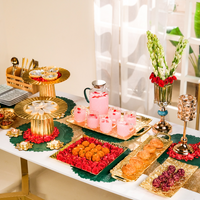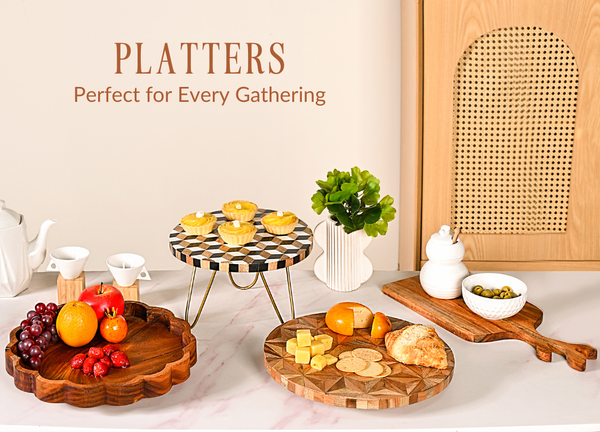Sugar, spice, and a whole lot of things that are nice!
The deliciously intriguing world of baking is often referred to as a science. And to a certain extent, it’s true. Baking is precision and method, but it’s also an art form. A symphony of flavours and textures, where every ingredient must be used with precision and purpose to create delectable delights that warm our hearts and nourish our souls.
However, baking for beginners can seem rather daunting. You see, beautiful readers, there’s a sea of information on the dos and don’ts, a correct series of steps to follow, and, at times, math that involves correctly converting certain measurements into larger or smaller quantities. But, like all things in life, with a little bit of practice and our quick crash course on all things you need to know, baking can quickly become one of your favourite pastimes.
So let’s dive right in.
Baking Basics- 4 Baking Tips for Beginners:
When it comes to baking for beginners, there are a few baking basics that are useful to have at the ready.
Accurate Measurements:
In the world of baking, nothing is more important than accurate measurements. All recipes, even baking recipes for beginners, require accurate measurements. And while you may think that some quantities being slightly over or under will have no effect, you need to think again. Small changes can result in major effects on the quality.
However, it’s not just the quantity that needs to be accurate. The method used to measure must be followed to the T as well. For example, if you weigh flour on a scale, you can measure sugar using a cup. Pick a method and stick to it.
Temperatures:
To make the best batter, temperatures matter. One of the best beginner baking techniques anyone can develop is having the patience to let all their ingredients get to room temperature.

Many ingredients, especially fats and eggs, change properties and the way they react depending on the temperature they are at. Moreover, when all the ingredients are at the same temperature, they emulsify better, resulting in a smooth batter that will bake uniformly to create a perfect product.
Nestip: Unless recipes specify the need for cold ingredients, always leave your ingredients on the countertop for 30 minutes before baking.
Leavening Agents:
One of the most important baking tips for beginners is knowing your leavening agents, i.e., baking powder and baking soda. While the two are often used synonymously as they serve the same purpose, they are both very different in nature.
Both are sodium bicarbonates; however, baking soda requires acid and moisture, such as buttermilk, to activate its leavening properties, thus allowing the batter or dough to rise. On the other hand, baking powder already consists of acid and a base needed to activate its leavening properties. This means that if you run out of baking soda, you can substitute it for baking powder, but not the other way around.
Preheating Ovens:
‘Preheating the oven’ is a common term that everyone has heard. Even when you bake savoury food, recipes often call for preheating the oven. It’s a fundamental beginner's baking technique that's been instilled in all of us. But do we know why it’s important?
Well, it’s simple, preheated ovens affect the overall success of the final product. From even baking and proper leavening to consistent results every single time, preheating your oven is crucial when it comes to achieving delicious baked goods.
6 Common Baking Ingredients:
Every baking recipe, including the baking recipes for beginners, requires the same essential ingredients.
Flour:
The base for any baking delight is flour. While there are many different flours, let's take a closer look at the essentials and the nice-to-haves:
Essentials:
-
All-purpose flour: The jack-of-all-trades flour - all-purpose flour is a must-have as it can create everything from breads, cookies, and cakes to breakfast favorites like pancakes and waffles.
Nice-to-Have:
-
Whole wheat flour: A healthy alternative that is mainly used for its nutritional value.
-
Self-rising flour: As it already has salt and baking powder mixed into it, it's recommended when it comes to baking for beginners as it simplifies the process.

Leaveners:
Leaveners are agents used to help your dough or batter rise; therefore, unless you’re trying to cook the world’s flattest cake, you need to have them in your pantry.
Essentials:
-
Baking powder: Used when you want a quicker rise.
-
Baking soda: Most often used in baking recipes that have natural acidity, like certain chocolate cakes and muffins.
-
Yeast: Traditionally used to leaven doughs such as breads, croissants, pizza, and other baked goods.
Sugars:
It’s the ingredient that makes them sweet… and addictive.
Essentials:
-
Granulated sugar: The typical white sugar recipes call for granulated sugar, which is a refined sugar that has been stripped of its natural molasses.
-
Brown sugar: Brown sugar is normal white sugar with added molasses and gives baked goods a richer, nuttier, and caramel-like flavour profile.
-
Powdered sugar: Often referred to as icing sugar, powdered sugar is finely ground granulated sugar used to create everyone’s favourite part of the cake- the icing.
Salt:
While salt may seem like an odd choice, it actually enhances and balances the overall flavour of the food.
Essentials:
-
Table salt: As it dissolves easily and isn’t overpowering, table salt is a go-to for bakers.
Nice-to-Have:
-
Flaky Sea-Salt: A boujee salt, flaky sea-salt is used as a finishing salt and often sprinkled over cookies and brownies to make our taste buds dance. As if we needed another reason to love them?!
Dairy:
Dairy is responsible for the texture and moisture and can affect the flavour of the final product. Therefore, it’s a staple in our book!
Essentials:
-
Unsalted butter: It's the de facto choice when it comes to baking for one very simple but crucial reason - different brands use different amounts of salt, and as a result, salted butter can greatly impact the overall flavour of the dish.
-
Eggs: Not just any sized eggs, but large ones. Any baking recipe for beginners that mentions eggs by default refers to large eggs.
-
Milk: No one likes dry, mealy cake, and that is where milk comes in. It’s the agent that gives baked goods their moisture. Whole-fat milk has a richer flavor as compared to low-fat milk.
Fats:
Fats are important for helping baked goods retain moisture.
Essentials:
-
Vegetable Oil: This has a neutral flavour and is great for oiling baking trays when baking cookies or bread.
-
Unsalted butter
2 Basic Beginner Baking Techniques To Learn
Mixing:
The fundamental baking technique that every baker must know is mixing, as the type of baking technique chosen to mix ingredients can greatly affect the good’s volume, appearance, and texture.
Mixing evenly distributed ingredients activates a flour's natural protein, allowing it to develop structure, breaks down fats and liquids, causing them to emulsify and thus turn mere ingredients into batters, and incorporates air, allowing goods to be lighter in texture.
There are nine different types of mixing techniques, each of which has its own crucial role to play in the overall process. Stirring, folding, sifting, and blending all ensure ingredients are combined properly. Cutting, while it also ensures ingredients are combined correctly, is primarily used to make the final product flaky. Beating, creaming, kneading, and whipping incorporate air into the batter. These air pockets are responsible for the texture of the final product. The more air, the fluffier and lighter the dish will be.
Preparing Baking Dishes:
Buttering or oiling your baking dishes or baking trays is extremely important to ensure our delicious sweet treats don’t stick to the pan and get ruined. However, over greasing can lead to greasy delights, soggy bottoms, and altered flavours. Therefore, it’s important to know these three simple steps to correctly grease our baking tools:
-
Using a paper towel, rub a small piece of butter around the tray, including the sides, to create a thin, even coating.
-
Next, sprinkle all-purpose flour into the dish, tilt, and shake until the entire dish is coated with a thin layer of flour.
-
Tip the excess aside, and your tray is good to go!
Baking Kit For Beginners | Essentials To Start Your Baking Journey
Skills and recipes are a must. Ideas are great. But in the world of baking, the right bakeware is the missing link that helps every baker concoct delicious treats. Baking dishes and trays lay the groundwork for a myriad of sweet creations, and every baker needs a few essential kitchen tools in hand to become a confident and accomplished baker.
However, if you’re throwing a tea party or helping your child with a school bake sale and want to ensure their baked goods are the first to be snatched off any cake stand, you need to invest in some high-quality baking moulds. Baking moulds help us create truly adorable and whimsy treats that add a visually appealing delight to the table, instantly living up the dinner table.
Conclusion
Baking. It’s the art of science, which is what makes it so daunting yet so beautiful. However, by going back to the fundamentals and being prepared with the basic tools and ingredients, baking will instantly become one of your favourite hobbies.
FAQs
How do I measure ingredients accurately for baking?
Investing in high-quality, standardized measuring tools, such as clear measuring cups and spoons for both wet and dry ingredients, is a must. When measuring dry ingredients such as flour and sugar, spoon them into the cup without packing and level off.
For liquid ingredients, use a clear measuring cup, checking at eye level on a flat surface. Maintain consistency in measuring techniques, whether for dry or liquid components, to ensure reliable results in your baking endeavours.
What are the common problems encountered in baking and how do you solve them?
While there are many problems bakers face, here are our top three problems and solutions:
Flat or Dense Cakes:
Flat or dense cakes are a result of rising problems. Therefore, ensure your leaveners (baking powder, baking soda, or yeast) are all fresh. Furthermore, ensure all ingredients are measured properly and avoid over-mixing.
Dry Cakes:
Dry cakes usually occur if not enough fats or liquids are used in the batter, the cake is overcooked, or the correct flour is not used or measured properly.
Uneven Baking:
Uneven baking refers to cakes that have parts that are overdone and underdone. To avoid this, ensure your batter is evenly distributed in the tray by tapping the baking tray flat on the surface with the batter in it. Furthermore, rotate your baking tray or baking dish halfway through the baking time.
























